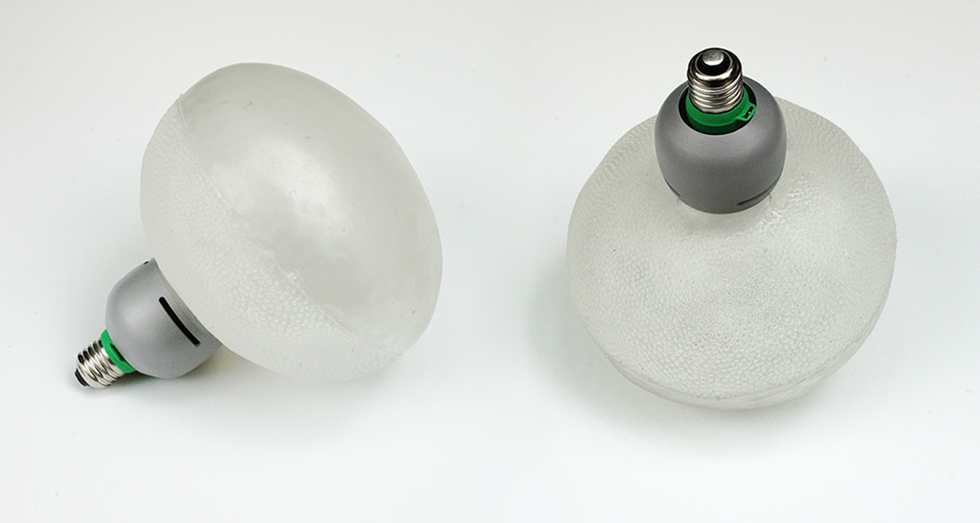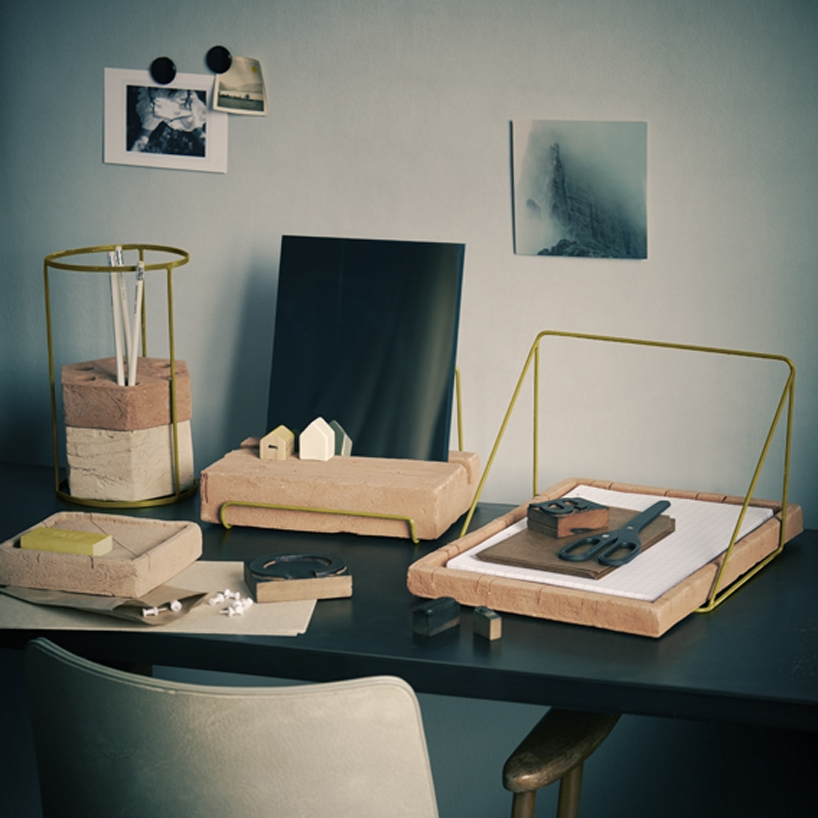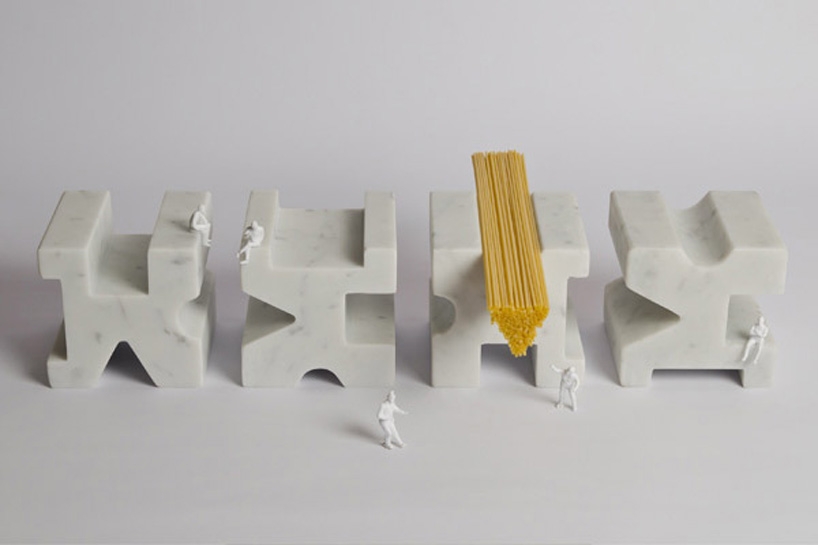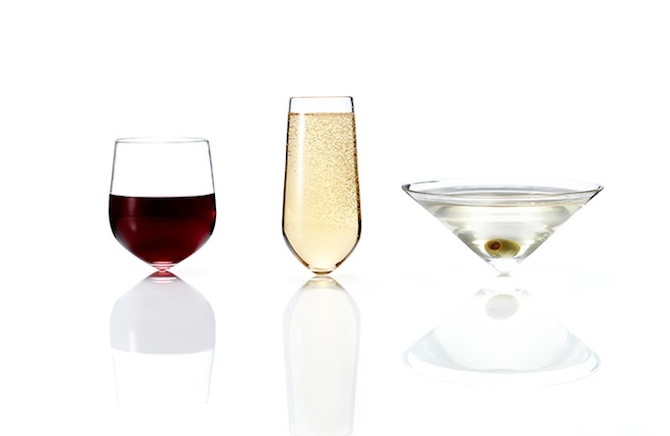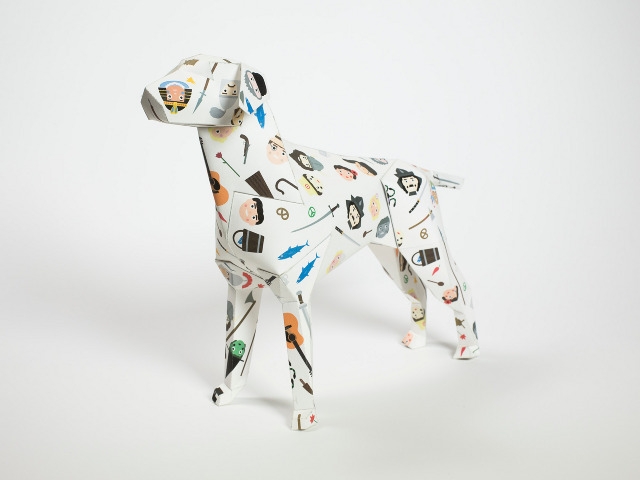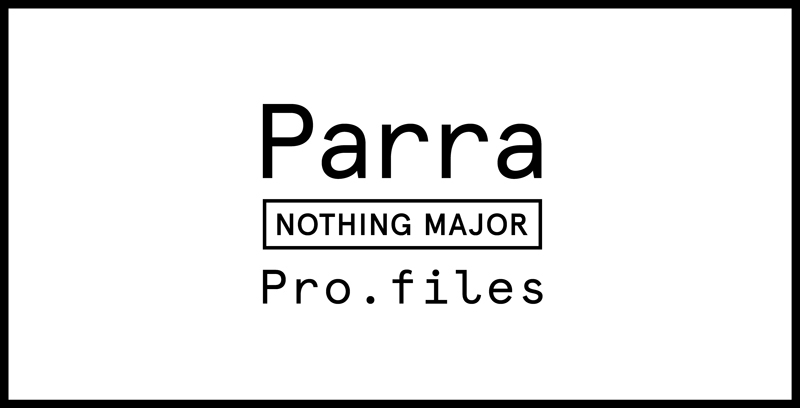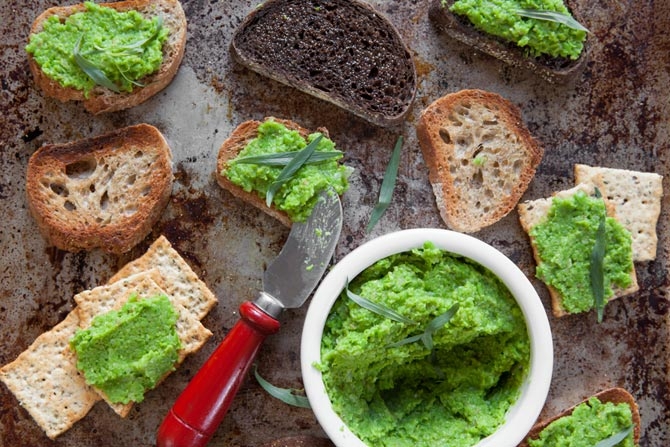The soft rubber bulb of Booo's new light fixtures doesn't just filter the LED light source. Designer Nacho Carbonell realized that shipping large (and fragile) glass light bulbs was an unnecessary risk and expense, so he set out to make a collapsible and attractive fixture that could ship more securely in a smaller package. The lamp's simple form is another conscious decision: the designer hopes it will be used as a standalone light fixture, but it's also simple enough to work inside a bigger lampshade.
Ilaria Innocenti's "Adobe" collection of desk tools is somewhat of a geological history exercise. Using ancient brick building techniques, Innocenti formed the pieces using different proportions of clay, silt, sand, and plant fibers. The slight variation in coloring reflects the different qualities of soil in her native Italy. [via designboom]


Sure, you could measure pasta without Studio Lievito's handsome marble Spaghetti Meter, but that's incredibly risky and we wouldn't recommend it. The Meter is dead simple to use: the carved shapes on each side of the block hold just enough pasta for one, two, three, or four people. Simply rotate the meter to the correct number of people you're feeding, fill with spaghetti or whichever long pasta you prefer, and cook. [via It's Nice That]
The Spaghetti Meter debuted during Milan Design Week. Check out more of Studio Lievito's kitchen wares, like hand-blown glass pasta holders and marble utensils, online.

Baccic Glasses look like typical stemware except for one major detail: they’re missing the stem. Designed by Joe Doucet, Baccic glasses bring a classy approach to drinking games. Unable to stand on their own, the glasses feature a round bottom which forces party attendees to finish the entire drink before they can set the glass down without spilling. This clever design is sure to result in a night that is as interesting as the glasses themselves.
In short, Gerald is a paper dog, originally concepted in 2008 for the rebranding of UK design studio Lazerian. After much trial and error, Lazerian's Liam Hopkins and 3D designer Richard Sweeney came up with a pattern that could be easily reproduced, handcut, folded, and glued into a free standing dog. Anyone can make Gerald with the blueprint, sharp knife, glue, and "a healthy degree of patience." Eventually, a small dog version was developed with just nine panels, while the studio created an 88-component larger version for itself. Gerald is based on the look of an Italian gun dog, which is perhaps why he looks so eager, loyal, and a bit hungry.
After a quick sell out of the flatpack at design events, the designers played with customizing their own Geralds, then launched the Gerald Project in 2011, shipping out flat dogs to their fave artists, designers, and creative folk.
Those lucky enough to be in Milan this week for the Salone del Mobile know that there is more going on than one can possibly see. One exhibition we'd put on the itinerary is "Danish Chromatism," designed by architects GamFratesi, which shows off contemporary and traditional design from 30 Danish companies. You might expect wood furniture in modern shapes, you know Danish Modernism-type stuff, but there's more happening.
The architects say their exhibit was inspired by Josef Albers and reinterprets the classic Danish aesthetic through color.
Participants (some of them direct competitors) include Fritz Hansen, LEGO, Libratone, Peter Klint, Royal Copenhagen, Stelton, and 8000c.
Head on over to the Triennale Design Museum to see it in person, you lucky devil. It runs April 9-14.
Decades back, home stereos were often proudly housed in handsome wood cabinets that kept power plugs out of sight, and often boasted their own built-in speakers. The new series from Gesa Hansen plays off those populist mid-century pieces, also keeps the wires under wraps, and offers high fidelity, all on a contemporary scale. The collaboration between The Hansen Family and Tivoli Audio offers two modern sound solutions for the home audio enthusiast. The first is the Radio Rack, a smaller piece in dark wood that doubles as a magazine display rack, while the second, the Sound Sideboard, is a substantial cabinet in sustainable wood with a special hinged back to conceal wires and room for two speakers. We'd have 'em both, if we could.



Designers Erin Huizenga and Deborah Alden are the types that get invited for coffee to talk shop. Both also teach at schools like Northwestern and IIT Institute of Design and work with socially conscious organizations like Firebelly University (where Alden was Dean) and EPIC (which Huizenga founded). But their experience, and a jolt of caffeine, hasn't always produced immediate answers, especially when questions came from mid-level designers looking to navigate to the next level of their career.
With their new design-centered educational organization, The Comradery, Huizenga and Alden decided to tap into community wisdom to provide answers to complex professional questions. Aiming to be an inclusive hub where students learn through participation, The Comradery plans to host classes focused on design thinking and leadership, starting with a kickoff event April 13, a design research workshop taught by IDEO’s Julka Almquist.
“We want to establish a culture of lifelong learning,” says Alden, “and doing things experientially.”
The upcoming workshop schedule suggests an interdisciplinary, professional approach: how to craft a compelling presentation by Dinesh Goburdhun, Associate Partner of Strategy at VSA Partners; entrepreneur Chris Finlay of Otabo discussing how to find the value of your business; and Alisa Wolfson, director of design at Leo Burnett, on finding inspiration in life and practice. By focusing on interdisciplinary topics and leadership, the learning experiences won’t just be relevant for designers, says Alden, but will benefit anyone interested in creative processes.
“The thing about a place like IDEO is, they aren’t all designers by trade, they become designers by using the process,” says Alden. “To me, the design process is a way of thinking laterally and asking the right questions. It can be mystical to people, and we want to pull back the curtains.”
Find more about The Comradery or sign up for the inaugural event.
Recently, Nothing Major caught up with Dutch artist Parra (who sells his wares under the Rockwell Clothing brand name) while he was in NYC for his "Tracy Had a Hard Sunday" solo show at Jonathan Levine gallery. In this exclusive video interview with Parra for our Pro.files video series, he tells us about his love of the T-shirt format and why he likes drawing the female form.
Video interview by Eavvon O'Neal, Music is "Benedict's Fence" by Wrong Season



A pop-up purveyor showcasing cutting-edge merchants and creatives from Chicago and the Midwest, Fête started last December as a hip holiday market showcasing artisanal food, vintage goods, and handmade creations. Now, founders Emily Fiffer, Heather Sperling, and Jessica Herman are positioning the recurring Chicago market at the intersection of food and design. With the next installment April 4-7, 2013, Fête expands its focus with a program of events and lectures celebrating and spotlighting the creative processes of an array of big names in food, design, publishing, and otherwise.
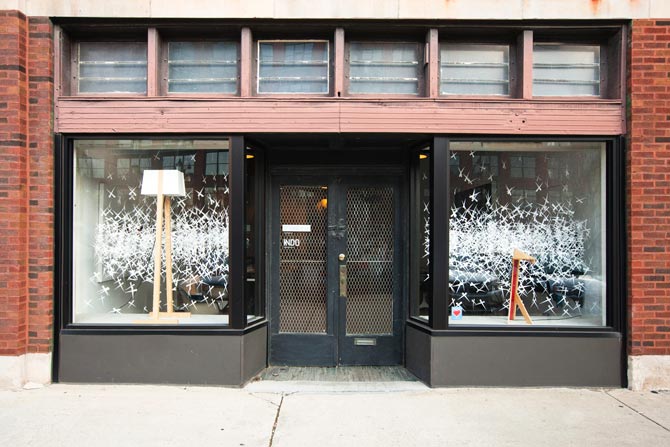
INDO studio
Design related highlights include:
April 5: Process and Raw Materials: Gillion Carrara, Kristin Mariani, and INDO’s Linsey Burritt and Crystal Grover
Moderated by Pitchfork and Nothing Major creative director Mike Renaud, this roundtable discussion focuses on theories of material and design, along with new directions being taken by jewelry and accessory designer Gillion Carrara, dressmaker and designer Kristin Mariani, and the INDO team, who creates site-specific installations and window displays from recycled materials. INDO, 5:30pm
April 6: Studio Tour: A Rare Glimpse into the World of Crucial Detail
Columbia College product design professor Kevin Henry will talk with Crucial Detail’s Martin Kastner, a blacksmith-turned-designer who collaborates with acclaimed chef Grant Achatz of Alinea and Next, about his next-level tableware and conceptualizing new ways to present inventive cuisine. Crucial Detail, 3:30pm
April 7: The Making of Middlewest: A Conversation with David Tamarkin, Erica Gannett, and Sonnenzimmer
Time Out Chicago food critic and Middlewest founder David Tamarkin, along with photographer Erica Gannett and design duo Sonnenzimmer, will break down the aesthetic choices and angles they took when creating this new Kickstarter-funded food magazine. Tamarkin will serve up opinions on the direction of culinary media, as well as his own homemade coffee cake. Rational Park, 11am
April 7: The Sea Inside: A Tour of Land and Sea Dept.
The Garfield Park creative space/clubhouse of Longman & Eagle co-owners Peter Toalson, designer Cody Hudson, and Robert McAdams, as well as Jon Martin of Mode Carpentry, opens its doors for a tour. Drinks and food come from the newly opened Parson's Chicken & Fish, while sausage samples and Jello shots are from Longman’s Off Site bar. Land and Sea Dept, 2pm
Curious about the fest's intersection of food and design, we queried Jessica Herman for more details.
Why do a food and design fest?
Emily, Heather, and I are all passionate about food and design, so the inspiration comes from a personal place of wanting to showcase the primarily locally based talent in the city. As far as a fest, we've been doing the market experience for a while, and it's definitely key to the experience. But we wanted to take Fête to the next level. Having the chance to taste the food and shop the vendors' goods is one part of the experience, and an important one. The market is a kick-off for the weekend with basically the best catering you could imagine—Longman & Eagle cocktails, Virtue cider, food from Trencherman, Ruxbin, Parson's Chicken & Fish, La Sirena Clandestina, and so many more—and a chance to shop designed goods from a phenomenal group of vendors, some who have a presence in stores in Chicago and others who don't. But we wanted more. We want to inspire deeper conversations, offer access people normally just don't have to studio spaces, places like The Plant and Crucial Detail and INDO's design studio. I love seeing people have a chance to talk with the makers at the market, but when it's busy, it's impossible to have an extensive conversation. These additional events throughout the weekend offer a chance to continue the conversations that begin at the market and take them even further. Almost all of the weekend's events have some kind of representation at the market. For instance, Kristin Mariani of Red Shift will be talking about her process and raw materials Friday night with INDO and Gillion Carrara is selling her reclaimed leather accessories at the market.
What's the connection?
There's a lot of overlap. Longman & Eagle is a perfect example. Here's a team of guys who are equally passionate about food and design who have collaborated to build one the best restaurants and the coolest inn in Chicago. The design of Longman & Eagle is as important as the food. When people step inside the Land and Sea Dept. headquarters at our event, they'll see how that collaboration takes place with their studios all situated right next to each other. They're all generating ideas and tapping each others' different expertise and skills to execute those ideas. Similarly, look at someone like Martin Kastner of Crucial Detail. One of the interesting topics he'll discuss during his tour of the Crucial Detail space on Saturday is how his creative process collaborating with Grant Achatz has evolved over the years. The ideas for food and presentation come from both directions. It's not only Grant coming to Martin with ideas for food or drink for which he needs a design solution at this point, but it's also Martin coming up with ideas that he'll pass along to Grant. The process for honing in on that final dish or drink you see in the restaurant then goes from there.
Why is Chicago a good place for this?
There are so many incredible artisans, chefs, and designers in Chicago, but there's a lot going on people have no idea exists. Chicago's very much a food town, so people tend to be aware of the new restaurants that open up. But beyond that, if it's not necessarily buzzy, there isn't enough awareness of the abundance of creative talent in the city. If you don't already exist in these worlds as a chef or designer or have a natural connection, you probably don't have ready access to these people or places. Why not open the doors to the spaces so more people can understand what happens behind the scenes?
